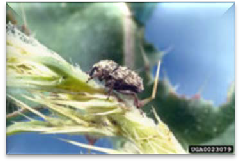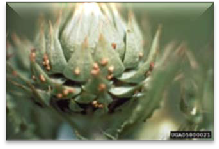Musk Thistle is a Class B Weed. In regions where a Class B species is already abundant, control is decided at the local level, with containment as the primary goal.
Musk thistle, (Carduus nutans L.), is an invasive weed that has become widespread in the contiguous states of the United States. It is a highly competitive weed of Eurasian origin that has replaced much of the native vegetation in pastures and disturbed areas. Musk thistle was introduced from Eurasia in about 1853.
Economic damage: Musk thistle invades pastures, rangeland, and forest lands, and areas along roadsides, railroad right-of-ways, waste areas, and stream banks. In agricultural systems, the invasive nature and prolific seed production of musk thistle result in large populations of the weed, which compete with crops for space, nutrients, and light. Thus, infestations may reduce productivity of pasture and rangeland by suppressing growth of desirable forage plants, as well as preventing livestock from eating plants growing in the vicinity of thistles due to the sharp spines on their stems, leaf margins, and blooms.
Successful biological control of musk thistle is often accompanied by increased growth and coverage of pasture grasses such as fescue (Festuca arundinaria Schreb.) and orchard grass (Dactylis glomerata L.), or less desirable plants such as spotted knapweed.
Photo by: Norman E Rees
Extent of losses: The rate of expansion of musk thistle populations in North America has been very rapid since the mid-1950s, when it was first recognized as a weed. A single musk thistle per 1.49 m2 can reduce pasture yields by 23%.
Geographical Distribution: Musk thistle was first reported in the United States in 1953 at Harrisburg, Pennsylvania.
Biology: Carduus nutans L. is an herbaceous biennial though occasionally it becomes a winter annual. It is 20 to 200 cm tall, with a long, fleshy taproot. Musk thistle grows in all soil textures, although the soils must be well drained. The plant blooms in May and June. It does not reproduce vegetatively and is propagated by seeds dispersed primarily by wind. One plant can set up to 20,000 seeds. However, only one-third of the seeds are viable.
Control Methods
Cultural control: Maintaining pastures and rangeland in good condition is a primary factor for musk thistle management. To favor pasture and rangeland grass growth, do not overgraze. Fertilize only when necessary and according to soil testing recommendations. To successfully manage musk thistle, prevent seed formation.
Mechanical control: Musk thistle will not tolerate tillage and can be removed easily by severing its root below ground with a shovel or hoe. These methods can be expensive.
Chemical control: Several herbicides are registered in pasture, rangeland, and noncrop areas to control musk thistle. Herbicides containing picloram, clopyralid, 2,4-D, triclopyr, and dicamba are commonly used. Apply these herbicides in spring or fall to musk thistle rosettes.
 Apply any of these herbicides before musk thistle bolts or seed production still will occur.
Apply any of these herbicides before musk thistle bolts or seed production still will occur.
Metsulfuron or chlorsulfuron with a surfactant can also be used. The latest time to apply these herbicides is when developed terminal flowers have opened up to the size of a dime.
More information can be found in the PNW Weed Management Handbook
Use pesticides with care. Apply them only to plants, animals, or sites listed on the label. When mixing and applying pesticides, follow all label precautions to protect yourself and others around you. It is a violation of the law to disregard label directions. Store pesticides in their original containers and keep them out of the reach of children, pets, and livestock.
Biological Control Organisms
Rhinocyllus conicus. This thistle-head weevil was the first insect introduced into North America for the biological control of musk or nodding thistle. It was collected from the Rhine Valley in France and released in Canada in 1968. In 1969, it was introduced into California.
Rhinocyllus conicus (seed-feeding weevil) a native of southern and central Europe, North Africa, and western Asia was approved and released in Canada (1968) and in the United States (1969).
R. conicus overwinters in the adult stage. It becomes active in mid to late April, depending on temperature. Each female lays about 100-200 eggs. Oviposition is well synchronized with musk thistle development. Eggs are laid on the bracts of developing buds and hatch in about 6 days. Newly hatched larvae feed through the bracts into the buds. The larvae feed on the receptacle and prevent the production of viable seeds. They complete development in 4 to 6 weeks and turn into pupae in the thistle heads.
Photos by: Loke Kok
Trichosirocalus horridus (Coleoptera:Curculionidae).Trichosirocalus horridus is a native of south and central Europe that feeds on the rosettes of Carduus thistles. This rosette weevil was the second insect introduced into North America for Carduus thistle control. It was imported from Italy into the USA in 1970-1972 for quarantine testing. Host specificity testing revealed that it would not be a threat to nontarget plants and it was approved for field release in Virginia in 1974.This rosette weevil has a single generation per year. Eggs are laid on the lower side of leaves along the midrib and the primary veins and hatch in about 13 days. Larvae migrate down the petiole to crowns to feed soon after hatching. Females often lay over 2000 eggs with the subsequent larval feeding stimulating the plant to form a multi-branched growth habit. Control of musk thistle is greatest when the two weevils (R. conicus and T. horridus) act in conjunction with plant competition.
revealed that it would not be a threat to nontarget plants and it was approved for field release in Virginia in 1974.This rosette weevil has a single generation per year. Eggs are laid on the lower side of leaves along the midrib and the primary veins and hatch in about 13 days. Larvae migrate down the petiole to crowns to feed soon after hatching. Females often lay over 2000 eggs with the subsequent larval feeding stimulating the plant to form a multi-branched growth habit. Control of musk thistle is greatest when the two weevils (R. conicus and T. horridus) act in conjunction with plant competition.
Photo by: Norman E Rees
Photo credits included in PDF



